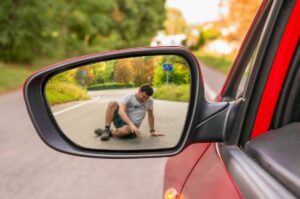Pedestrian accidents usually happen when drivers operate their vehicles negligently, but what are the common causes of pedestrian accidents? At times, these accidents occur when roadways, sidewalks, parking lots, and parking garages have large cracks, potholes, and other defects. Pedestrian accident victims often sustain serious injuries that leave them hospitalized and needing ongoing medical treatment. Moreover, when a pedestrian suffers injuries in an accident, they may experience permanent pain and symptoms.
If you or someone you care about suffered injuries in a pedestrian accident, you should always retain an experienced lawyer to represent you in your case right away. Representing yourself in a personal injury claim or a lawsuit is never a good idea since the at-fault party’s insurance company will likely make you a sub-par settlement offer. This is because insurance companies and their adjusters usually assume that self-represented accident victims do not have the necessary negotiation and litigation skills to resolve their cases profitably.
A skilled Denver pedestrian accident lawyer in your area can undertake an investigation to determine how your accident occurred. Moreover, if you are eligible to file a claim for damages, your lawyer can assist you throughout every step of the process and help you negotiate a fair offer with the insurance company.
If the insurance company refuses to offer you reasonable damages, then your lawyer can file a lawsuit against the at-fault party and litigate your case to a conclusion in the court system. Your lawyer can answer all of your legal questions and help you make informed decisions during your personal injury claim or lawsuit.
Common Pedestrian Accident Injuries
When a vehicle strikes a pedestrian in an accident, it is almost always the pedestrian who suffers the more severe injuries. The force of impact from a car or truck may knock a pedestrian to the ground, causing them to sustain painful and debilitating injuries. The same holds true if a sidewalk or roadway defect causes a pedestrian to trip and fall.
The extent of an accident victim’s injuries typically depends upon the amount of force with which they strike the ground and which body part(s) they strike on the ground. Common pedestrian accident injuries include traumatic head and brain injuries, soft tissue contusions, broken bones, spinal cord injuries, abrasions, road rash, bruises, internal organ damage, paralysis, and death.
If you suffered any of these injuries in your pedestrian accident, you should seek prompt medical attention right away—preferably on the same date as your accident. When you go to a hospital emergency room or urgent care facility, the provider on duty can render emergency assistance, take the necessary imaging studies, physically examine you, and diagnose your condition.
Depending upon the circumstances, you may need to seek follow-up medical intervention after your emergency room visit. The ER doctor can make the necessary treatment recommendations, including following up with your primary care doctor, neurologist, orthopedic doctor, or physical therapist.
Seeking prompt medical treatment is vital because it shows insurance companies that your injuries are serious—and that you take your medical treatment seriously. It also helps prevent already serious injuries from becoming worse over time.
While you finish your medical treatment after a pedestrian accident, your lawyer can begin advocating for you and handling the legal aspects of your claim. Specifically, your lawyer can gather your medical records and bills to date, as well as any lost wage documents from your employer. Moreover, your attorney can obtain a copy of the police report, photographs of the accident scene, pictures of your injuries, and a victim impact statement that you prepare.
Once you finish treating, your lawyer can submit all of these documents to the insurance company adjuster, as well as a settlement demand letter, and begin settlement negotiations in your case. Your lawyer can then help you pursue maximum compensation for your injuries.
How Pedestrian Accidents Typically Happen
Pedestrian accidents may occur anywhere that pedestrians are present, including in parking lots and parking garages. These accidents may also happen within crosswalks and on sidewalks, especially those near busy traffic intersections.
Most pedestrian accidents result from driver error. For example, the driver might violate a rule of the road, engage in distracted or intoxicated driving, or fail to use their side view and rearview mirrors—especially when backing out of a parking space.
First, drivers have a duty to follow all road rules and regulations. When they deviate from these rules, they increase their chances of causing a motor vehicle or pedestrian accident. This is especially true when drivers speed or fail to yield the right-of-way at the proper time. When drivers run a red or yellow traffic light, stop sign, or yield sign, they may not see a pedestrian in the vicinity—or their speed might prevent them from stopping in time to avoid a collision.
Other pedestrian accidents happen when drivers fail to watch the road attentively. For example, a distracted driver might send a text message or email while driving, or they may fiddle with a GPS device instead of watching the road. At other times, drivers become distracted when they listen to loud music in their vehicle or turn their heads to discipline a young child sitting in the backseat. Even when a driver diverts their attention from the road for one or two seconds, they may not notice a nearby pedestrian, negligently striking them and causing them to hit the ground forcefully.
In addition to distracted driving, another common cause of pedestrian accidents is intoxicated driving. Passenger vehicle drivers who have a blood alcohol concentration (BAC) of at least 0.08 percent are legally intoxicated. The BAC cut-off for commercial drivers, including tractor-trailer and big rig operators, is 0.04 percent. The law considers minor drivers under 21 years of age legally intoxicated with a BAC of 0.02 percent or higher.
When drivers are under the influence, they usually exhibit physical symptoms, including bloodshot eyes and blurry vision. They may also experience an inability to concentrate and delayed reaction time. Consequently, they may be unable to stop their vehicle in time to avoid striking a pedestrian on or near the road. Moreover, some drunk drivers’ vehicles careen out of control, jumping a curb and hitting a pedestrian on the sidewalk.
Moreover, some pedestrian crashes occur when drivers fail to use their rearview and side view mirrors. Drivers may not adjust or look into their mirrors when backing their vehicle out of a parking space in a lot or garage. Consequently, they may not see a pedestrian who is walking behind their vehicle.
Finally, some pedestrian accidents do not result from driver error but instead result from roadway and sidewalk defects. Cities, municipalities, and other entities are responsible for adequately maintaining sidewalks and roadways in their jurisdictions. Specifically, they must warn about or properly repair these defects within a reasonable time.
When streets and sidewalks contain large cracks, spalling, and potholes, a pedestrian may trip and fall, suffering severe injuries. In those instances, an injured pedestrian can file a claim or a lawsuit against the municipality responsible for maintaining the sidewalk or roadway.
If you suffered injuries in a pedestrian accident resulting from negligence, an experienced personal injury lawyer in your area can explain your legal rights to you. Your lawyer can then help you decide the best course of action for your case and help you file the necessary claim or a lawsuit against all potentially responsible parties.
Recovering Damages after a Pedestrian Accident
When pedestrian accident victims suffer injuries, they usually incur high medical costs due to their treatment. They may also need to miss time from work to attend medical appointments and recover from their injuries.
To recover damages in a pedestrian accident claim, the accident victim has the sole legal burden of proof. Therefore, they must establish each element of their claim. First, the accident victim must demonstrate that the at-fault party behaved unreasonably or negligently under the circumstances, causing the pedestrian accident. The accident victim must also show that they suffered at least one injury in their accident—and that their injury directly resulted from the subject accident. Once they prove these legal elements, they may be eligible to recover various damages.
The total amount of damages that a pedestrian accident victim recovers in their case will depend upon the nature and extent of their injuries, the scope of their medical treatment, the cost of their treatment, and other related factors. Since all pedestrian accident cases differ, some accident victims may recover higher or lower compensation than other accident victims.
In general, pedestrian accident victims may pursue monetary compensation for their:
- Medical expenses
- Lost wages
- Pain and suffering
- Inconvenience
- Loss of earning capacity
- Permanent disfigurement
- Loss of use of a body part
- Loss of life enjoyment
- Loss of spousal consortium and companionship
Your lawyer can help you determine which of these damages you may recover in your pedestrian accident case and your likelihood of recovering those damages.
How the Claims-filing Process Works
 The first step to pursuing monetary compensation after a pedestrian accident is to file a claim with the at-fault party’s insurer. In addition to submitting a settlement demand letter to the insurance company adjuster, your lawyer can submit all relevant documentation, including your medical bills and records, for the settlement adjuster’s review.
The first step to pursuing monetary compensation after a pedestrian accident is to file a claim with the at-fault party’s insurer. In addition to submitting a settlement demand letter to the insurance company adjuster, your lawyer can submit all relevant documentation, including your medical bills and records, for the settlement adjuster’s review.
After reviewing these documents, your lawyer and the settlement adjuster may begin negotiations. Since first-time settlement offers are usually far below the actual value of a pedestrian accident claim, your lawyer may need to negotiate with the adjuster several times. During this back-and-forth process, the adjuster may gradually increase their offer.
If you ultimately accept a settlement offer, the case is over, and it will not proceed to a jury trial. However, if the insurance company disputes liability in your pedestrian accident case—or if they simply fail to offer you sufficient compensation—your lawyer may need to file a lawsuit in court on your behalf.
Litigating a Pedestrian Accident Case
In pedestrian accident cases, litigation begins when the accident victim’s lawyer prepares a lawsuit and files it in the court system. Even after taking this step, your lawyer may continue their settlement negotiations with the insurance company, and the case may still resolve well before trial. However, during litigation, the court will usually enter a scheduling order and set deadlines for various case milestones—including discovery.
During discovery, the parties exchange answers to written questions, called interrogatories, and take discovery depositions. Your lawyer can help you with every step of the litigation process and, if necessary, take your case to trial or binding arbitration once discovery concludes.
If your case goes to trial, a jury will decide the amount of compensation to award you for your injuries. However, if your case goes to binding arbitration, which is a type of alternative dispute resolution proceeding, a neutral arbitrator will decide the total damages you recover. Your lawyer can help you make important decisions during litigation, including whether to accept or reject a pending insurance company settlement offer or take your case to trial or binding arbitration.
Call a Pedestrian Accident Attorney Near You Today
If you sustained injuries in a recent pedestrian accident, time is of the essence. In fact, pedestrian accident victims only have two years from their accident date to file a claim or lawsuit that seeks monetary damages. If they do not file their lawsuit within those two years, they will not be eligible for damages at any future time. If they later try and file a lawsuit, the court will promptly dismiss it. Therefore, if you suffered injuries in a pedestrian accident, you should talk with a knowledgeable Denver personal injury lawyer in your area immediately.
Your lawyer can help you file the necessary claim or lawsuit within the statutory timeframe. Moreover, your lawyer can investigate your claim, negotiate with the insurance company on your behalf, and, if necessary, file a lawsuit in court and help you throughout the litigation process.
Your lawyer will highlight the strengths of your pedestrian accident case while downplaying any weaknesses and help you pursue the highest amount of damages available for your accident-related injuries.




















